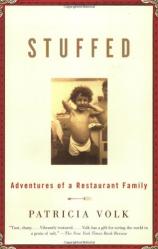Reading Group Guide
Discussion Questions
Stuffed: Adventures of a Restaurant Family

1. What is the effect of the contents page? Why does Patricia Volk choose to organize the story of her family history around food? How has growing up in the restaurant business shaped her consciousness?
2. How does Volk's approach to food differ from that of professional food writers or chefs whose memoirs you might have read? How does this book invite the reader to reflect on his or her own family's history through its culinary habits? Might it be said that every family has its own unique gastronomic history and identity?
3. Judging from the recipes Volk presents in the book, how would you characterize the foods of her youth? See the restaurant menu on pages 165—66 or the recipes she makes while trying to learn to cook. Is there anything remarkable about these menus and recipes? How does the food appear in light of the last few decades' emphasis on fresh produce and low-fat meals?
4. What are some of the less appealing aspects of Volk's family life? How does she learn to be tolerant of people's habits or defects of character? Does Volk come across as an unusually tolerant and loving person?
5. Can the traits and habits of the extended Volk and Morgen families–extensive connectedness and conversation, regular get-togethers, card-playing evenings, etc.,–be found in present-day American families, or does Stuffed describe a way of life that has largely vanished?
6. What role does food play in the author's relationship with Mattie? How relevant is Mattie's race to her place in the Volk family, particularly in Patricia Volk's emotional development?
7. In the chapter called "Hersheyettes," Volk reflects upon her relationship with her sister and upon their shared obsession with dieting. Dieting presumes an ideal; what is the ideal to which the sisters feel beholden? Why does Volk decide that if she ever has a daughter, she'll make sure her daughter isn't "tyrannized by beauty" [p. 152]?
8. In what ways is Stuffed a book about Jewish life, and how important is the fact that Volk's family was not religiously observant? How is Jewish identity defined in this memoir? What objects, clothing, and places contribute to a sense of Jewishness for Volk's family?
9. To what degree does Stuffed express a sense of nostalgia for childhood, for a sheltered existence, and for an earlier time? How realistically does Volk recall the atmosphere of middle-class family life in the middle decades of the twentieth century?
10. See the discussion of the word "piquant," or the description of Granny's V-8 carrot salad [p. 149]. How does Volk reproduce the sensation of eating? What are the challenges inherent in writing about eating?
11. Why, towards the end of the book, does the restaurant close, and what does this say about what has changed in New York City? What might the objects that Volk saves symbolize for her?
12. Why has Volk chosen "Stuffed" as her title? What does it mean to be stuffed? What is the relationship between being satiated and being stuffed? Is there a fine line between being comfortably satisfied and feeling dangerously overindulged?
13. Comment on the book's structure. What is the time frame, and how often does Volk break with a simple chronological presentation of events? Why does Volk often break the flow of her narrative, or seem to change the subject? What effect does her approach to structure have on the reading experience?
14. Volk reflects, "In a family you don't come from nowhere. You enter the world already a part of something. . . . Knowing so much about them, how open-hearted can you bear to be? You are born with the chance to love them. You might as well. They're yours" [pp. 230—31]. How valuable is this piece of advice? How accurately does it sum up Volk's approach to her own family?
Stuffed: Adventures of a Restaurant Family
- Publication Date: October 22, 2002
- Paperback: 256 pages
- Publisher: Vintage
- ISBN-10: 0375724990
- ISBN-13: 9780375724992







